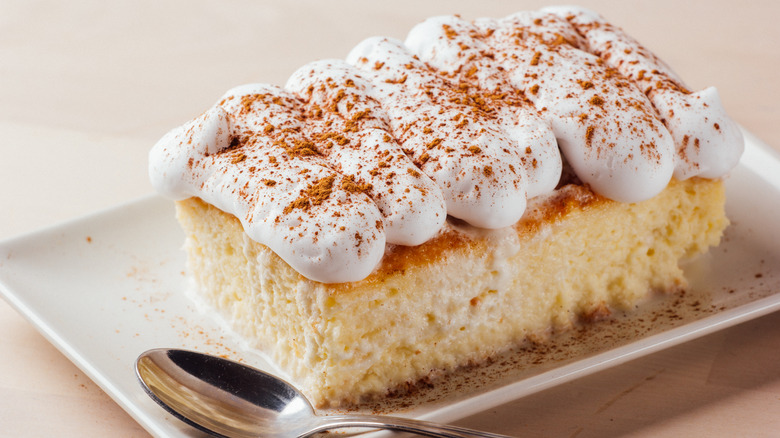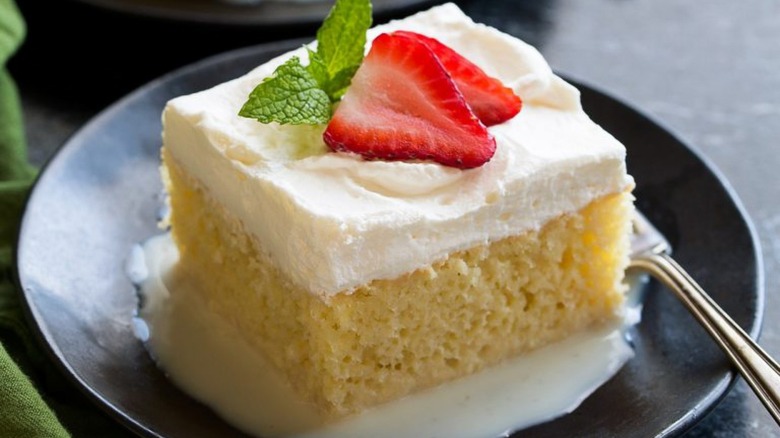What Is Tres Leches Cake And Why Doesn't It Get Soggy?
As you explore Mexican desserts, tres leches cake undoubtedly stands out. The name translates to "three milks," yet it doesn't refer to the liquid ingredients in the batter. Traditionally, a vanilla sponge is baked and then drenched in a mixture of sweetened condensed milk, evaporated milk, and whole milk, though sometimes cream replaces the latter. Preparing one from scratch might seem like an excessive amount of liquid to pour over a cake, but, remarkably, a perfect tres leches cake emerges — moist, but not soggy; tender, but not mushy; creamy, yet still distinctly cakey.
You might wonder how such a decadent dessert avoids becoming soggy. The secret lies in the sponge's structure. Generally, a tres leches cake recipe benefits from a light and airy sponge that excludes fat like butter or oil. This loose crumb structure allows the milk to permeate all the pockets without overly weighing down the cake. However, if you prefer a denser, more custard-like tres leches, opting for a recipe that includes some fat might suit your taste better, though you risk a mushier outcome.
More tips for sog-free tres leches cake
The cake's lightness is achieved by aerating the batter, often through extensive egg beating. This can be done in two ways: whisking whole eggs with sugar until they're voluminous and pale yellow, which can take around 10 minutes, or separating the yolks and whites, beating them with sugar separately, and then whipping the egg whites to soft or stiff peaks. The fluffy egg whites are then folded into the batter last. Regardless of the recipe you choose, diligent egg whipping is crucial.
Additionally, cooling the cake for at least 30 minutes before soaking it in milk is essential. If the cake is too warm, the added liquid will likely turn it into mush. After adding the three milks, it's crucial to let the cake soak and set in the refrigerator for a few hours, or even overnight. The temptation to indulge immediately is strong, but a little patience is what distinguishes a merely wet cake from a creamy, cohesive dessert.
Subtle riffs on a classic
Tres leches cakes can range from simple to elaborate — the choice is yours. However, there's merit in sticking to straightforward ingredients, like a basic sweetened whipped cream or meringue topping, allowing the milky flavor to really shine. After all, it is a milk cake. Depending on your taste, a light dusting of cinnamon or a drizzle of homemade caramel sauce — we suggest boiling your own dulce de leche — can add a nice touch.
For those wanting to get creative while maintaining the cake's integrity, consider substituting the milks with non-dairy alternatives. This is not only a thoughtful option for those with dietary restrictions, but also a way to introduce new and delightful flavors. Almond milk can replace whole milk, enhanced by a bit of almond extract and garnished with toasted almonds for a delicious twist. Cream of coconut is a great substitute for sweetened condensed milk, and when paired with coconut milk and topped with toasted coconut, introduces a delectable, nutty flavor.
Canned or fresh fruits are also popular toppings for tres leches cake. Peaches, mangoes, strawberries, kiwis, or passion fruit can elevate the dessert. A swirl of passion fruit pulp or curd adds a sweet-tart tang that balances the cake's richness.



